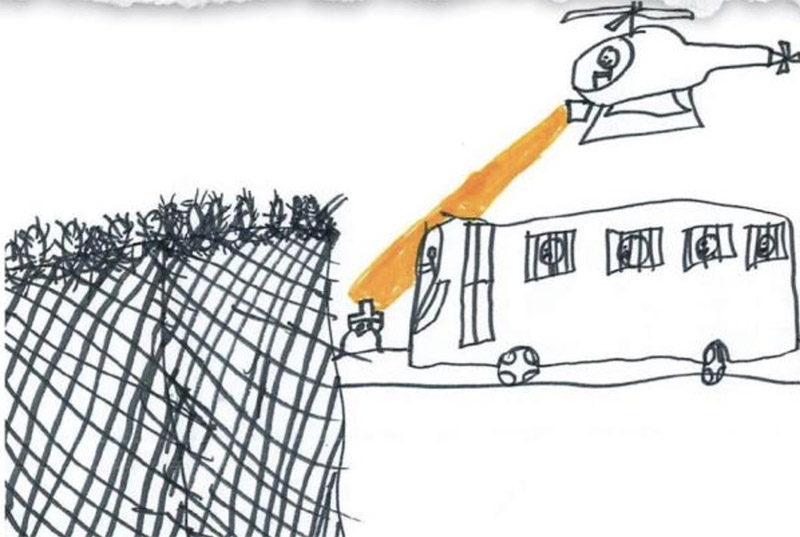
Some books shouldn’t have to exist, but you’re glad they do. This one describes a whole field of work — using art-creation to help kids in Arizona and Southern California deal with trauma created by anti-immigrant policies and attitudes — which shouldn’t have to exist, but you’re glad it does. The book is called Drawing Deportation: Art and Resistance Among Immigrant Children by Sylvia Rodriguez Vega. The author has worked with kids in school classes, helping them to create drawings (many of them included in the book) and improvisational theater productions, to express what they’re feeling and to begin to overcome some of their fear and anger.
Some of these kids have had parents or other loved ones seized, jailed, and deported. Some have risked their lives crossing an imaginary line on the Earth. Some have had loved ones die in that effort. All have experienced living with fear of police, with the discrimination of second-class status, and with racist attitudes. All have also lived with the impact of the poisonous talking boxes that their families impose on their living rooms. Much of what disturbs them is the media creation of national news narratives and the characters who act out those dramas, including people like Donald Trump and Sheriff Joe Arpaio, as well as those who selectively generate pseudo-outrage over the caging of immigrants depending on the political party of the U.S. president at the time.
One would like to hope that these young students’ artwork would do more than just help them to psychologically resist, that it would also help teachers to learn the value of such art projects, and — even more so — help people in general to develop the will to put an end to hateful policies and attitudes toward immigrants. The policy, for example, of making children “legal” but leaving their parents subject to being snatched and deported at any moment is not a policy of kindness to children. Not only are those children left without parents — in the name of upholding the Family or Freedom or The Rule of Law or god knows what — but they are also, predictably enough, left with the fear of being snatched and deported themselves. It’s not an easy fear to live with. Would you want yourself or your children to live with it? Would you not much prefer to get the U.S. government to stop sanctioning, punishing, militarizing, and degrading countries south or its border, 200 years into the Monroe Doctrine, thereby reducing the need for people to flee north? Would you not prefer to let those who come north go back south and back north again, with the billions now invested in militarizing the border becoming available for something useful?
One would like to hope, also, that another lesson might be drawn from this book. The same media outlets that traumatize immigrant children teach them solutions that will not work. Having consumed countless dramas in which violence ridiculously solves everything, these children fantasize about similar actions. They’ve learned from Hollywood that a “sniper” is a hero, even if they don’t have any interest in killing Iraqis. The single most popular solution to immigration issues that comes up in their theater improv is the assassination of Donald Trump. No school has taught them that nonviolent action works or that cycles of violence fail. No school has taught them that structural injustice requires a structural solution. No school has taught them that the deportation record belongs to President Obama, or that the number of detainees has soared under President Biden, or that the U.S. government has no pro-immigrants’ rights political party.
These would be very easy things to teach, but someone would have to do it. They would be up against, not only the enormous impact of the television, but also the whole life situation of these kids. They know that they can’t go to college without proper papers, not to mention truckloads of money. They are among the most heavily recruited targets for entry into the U.S. military. The people they see exercising power are mostly police. One of the few jobs open to them is that of joining the police. For some of them, Mexican warlords have a mythical Robin Hood status derived from the supposedly just use of violence. Even if one day a year someone says the name Cesar Chavez, that hardly undoes cultural saturation with the false goodness of violence and murder.
In some of the artwork these kids have created, peace and understanding are reached. Someone like them shakes hands with, talks with, and persuades Trump or Arpaio or a cop. There’s probably not a single adult Trump supporter or opponent who would do anything other than laugh at the idea of an immigrant speaking with him and changing his mind. I myself don’t find the question of what goes on in his mind worth considering at all. But the goal of making peace through dialogue, even if cartoonishly represented by buffoonish media characters who stand in for entire institutions, is exactly the right goal — and hopefully one advanced by the artworks envisioning it.

